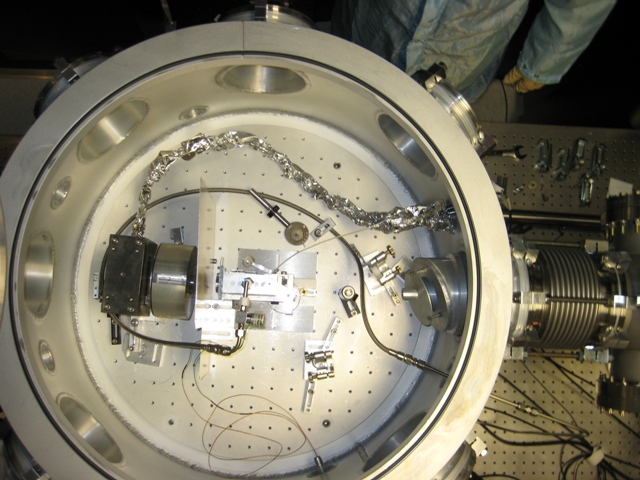Jun 21 2013
Physicists at The University of Texas at Austin have built a tabletop particle accelerator that can generate energies and speeds previously reached only by major facilities that are hundreds of meters long and cost hundreds of millions of dollars to build.
 The interior of the vacuum chamber in which the acceleration occurs. The laser beam arrives from the right. The gas cell, within which the acceleration of electrons occurs, is in the center of the chamber. The actual acceleration occurs over a distance of about an inch.
The interior of the vacuum chamber in which the acceleration occurs. The laser beam arrives from the right. The gas cell, within which the acceleration of electrons occurs, is in the center of the chamber. The actual acceleration occurs over a distance of about an inch.
“We have accelerated about half a billion electrons to 2 gigaelectronvolts over a distance of about 1 inch,” said Mike Downer, professor of physics in the College of Natural Sciences. “Until now that degree of energy and focus has required a conventional accelerator that stretches more than the length of two football fields. It’s a downsizing of a factor of approximately 10,000.”
The results, which were published this week in Nature Communications, mark a major milestone in the advance toward the day when multi-gigaelectronvolt (GeV) laser plasma accelerators are standard equipment in research laboratories around the world.
Downer said he expects 10 GeV accelerators of a few inches in length to be developed within the next few years, and he believes 20 GeV accelerators of similar size could be developed within a decade.
Downer said that the electrons from the current 2 GeV accelerator can be converted into “hard” X-rays as bright as those from large-scale facilities. He believes that with further refinement they could even drive an X-ray free electron laser, the brightest X-ray source currently available to science.
A tabletop X-ray laser would be transformative for chemists and biologists, who could use the bright X-rays to study the molecular basis of matter and life with atomic precision, and femtosecond time resolution, without traveling to a large national facility.
“The X-rays we’ll be able to produce are of femtosecond duration, which is the time scale on which molecules vibrate and the fastest chemical reactions take place,” said Downer. “They will have the energy and brightness to enable us to see, for example, the atomic structure of single protein molecules in a living sample.”
To generate the energetic electrons capable of producing these X-rays, Downer and his colleagues employed an acceleration method known as laser-plasma acceleration. It involves firing a brief but intensely powerful laser pulse into a puff of gas.
“To a layman it looks like low technology,” said Downer. “All you do is make a little puff of gas with the right density and profile. The laser pulse comes in. It ionizes that gas and makes the plasma, but it also imprints structure in it. It separates electrons from the ion background and creates these enormous internal space-charge fields. Then the charged particles emerge right out of the plasma, get trapped in those fields, which are racing along at nearly the speed of light with that laser pulse, and accelerate in them.”
Downer compared it to what would happen if you threw a motorboat into a lake with its engines churning. The boat (the laser) makes a splash, then creates a wave as it moves through the lake at high speed. During that initial splash some droplets (charged particles) break off, get caught up in the wave and accelerate by surfing on it.
“At the other end of the lake they get thrown off into the environment at incredibly high speeds,” said Downer. “That’s our 2 GeV electron beam.”
Former UT Austin physicist Toshiki Tajima and the late UCLA physicist John Dawson conceived the idea of laser-plasma acceleration in the late 1970s. Scientists have been experimenting with this concept since the early 1990s, but they’ve been limited by the power of their lasers. As a result the field had been stuck at a maximum energy of about 1 GeV for years.
Downer and his colleagues were able to use the Texas Petawatt Laser, one of the most powerful lasers in the world, to push past this barrier. In particular the petawatt laser enabled them to use gases that are much less dense than those used in previous experiments.
“At a lower density, that laser pulse can travel faster through the gas,” said Downer. “But with the earlier generations of lasers, when the density got too low, there wasn’t enough of a splash to inject electrons into the accelerator, so you got nothing out. This is where the petawatt laser comes in. When it enters low density plasma, it can make a bigger splash.”
Downer said that now that he and his team have demonstrated the workability of the 2 GeV accelerator, it should be only a matter of time until 10 GeV accelerators are built. That threshold is significant because 10 GeV devices would be able to do the X-ray analyses that biologists and chemists want.
“I don’t think a major breakthrough is required to get there,” he said. “If we can just keep the funding in place for the next few years, all of this is going to happen. Companies are now selling petawatt lasers commercially, and as we get better at doing this, companies will come into being to make 10 GeV accelerator modules. Then the end users, the chemists and biologists, will come in, and that will lead to more innovations and discoveries.”